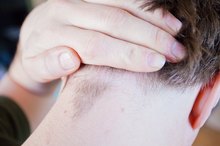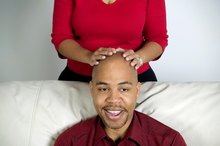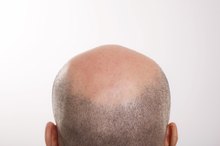White Bumps After Shaving
Most people who shave experience skin irritation from time to time. This irritation may take different forms, but if your recently shaved skin has broken out in small white pimple-like bumps, you probably have folliculitis, which can affect people of all ages 2. Though it may be itchy and unsightly, folliculitis is rarely serious and can usually be treated at home 2.
Identification
Folliculitis is a common infection of the hair follicles, the openings in your skin where hairs come through 2. It typically appears in areas where you've shaved as small, white and itchy pus-filled bumps surrounding individual hair follicles. These bumps may be tinged with blood or may break open and crust over.
Causes
How to Treat Ingrown Hairs on the Scalp
Learn More
The friction from shaving can damage hair follicles, which then become infected with a fungus or a bacteria such as Staphylococcus. Folliculitis can also occur when the shaved hairs begin growing in and curl back around to the skin 2. Even if you haven't shaved recently, folliculitis can result from the friction of clothing rubbing against skin or excess perspiration 2.
Treatment
Most cases of folliculitis from shaving are mild enough to clear up on their own; however, if the white bumps are uncomfortable or unsightly, you may wish to speed up their healing at home 2. Apply a warm wet washcloth to the bumps several times per day and wash the area with an antibacterial soap or apply an over-the-counter antibiotic ointment. Hydrocortisone cream or an oatmeal-based lotion may help ease itchiness.
Prevention
How to Get Rid of Folliculitis Scars
Learn More
If you shave regularly, folliculitis may be a constant battle for you 2. To prevent white bumps before they appear, use a clean, sharp blade every time you shave or try using an electric razor. Keep the shaved area as clean as possible by washing regularly or swiping the skin with an antibacterial toner, and avoid hot tubs, where high levels of bacteria are present. If these measures don't help, consider using an alternative method of hair removal in the areas you usually get bumps.
- If you shave regularly, folliculitis may be a constant battle for you 2.
- Keep the shaved area as clean as possible by washing regularly or swiping the skin with an antibacterial toner, and avoid hot tubs, where high levels of bacteria are present.
Warning
While folliculitis usually clears on its own, occasionally it may not respond to treatment or the infection may spread to other parts of your body 2. Notify your doctor if the bumps don't show improvement after two to three days of self care or if you develop a fever or feel warmth or pain in the affected area.
Related Articles
References
- Cleveland Clinic: Common Skin Infections
- Penn State: Folliculitis
- Palo Alto Medical Foundation: Pubic Hair Removal: Shaving
- University of Michigan Health System: Folliculitis
- American Academy of Dermatology Association. Acne-like breakouts could be folliculitis.
- U.S. National Library of Medicine. MedlinePlus. Folliculitis. Reviewed October 8, 2018.
- Merck Manual Professional Version. Folliculitis, Revised September 2019.
- American Osteopathic College of Dermatology. Folliculitis.
- Fearfield, L.; Rowe, A.; Francis, N.; et al. "Itchy folliculitis and human immunodeficiency virus infection: clinicopathological and immunological features, pathogenesis and treatment." British Journal of Dermatology. 2009; 141(1):3–11.
- U.S. Department of Veteran Affairs. "Dermatologic Conditions: Primary Care of Veterans with HIV - Organ Systems and Metabolic." October 8, 2011; Washington, D.C.
Writer Bio
Kristen Fisher is a freelance writer and editor with professional experience in both print and online media. She has published articles on a wide variety of topics including health, fitness, nutrition, home and food, and her work has appeared in "Connections Magazine" and on Lifescript.com. She graduated from the University of Arizona with a degree in psychology.









